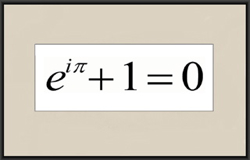Difference between revisions of "Elegance"
(Created page with 'File:lighterstill.jpgright|frame|<center>[[ Euler's Relation</center>]] *[http://en.wikipedia.org/wiki/16th_century ca. 1510] ==Definitions== *1...') |
m (Text replacement - "http://" to "https://") |
||
| Line 1: | Line 1: | ||
[[File:lighterstill.jpg]][[Image:Beauty low res.jpg|right|frame|<center>[[ Euler]]'s Relation</center>]] | [[File:lighterstill.jpg]][[Image:Beauty low res.jpg|right|frame|<center>[[ Euler]]'s Relation</center>]] | ||
| − | *[ | + | *[https://en.wikipedia.org/wiki/16th_century ca. 1510] |
==Definitions== | ==Definitions== | ||
*1a : refined [[grace]] or [[dignified]] propriety : urbanity | *1a : refined [[grace]] or [[dignified]] propriety : urbanity | ||
| Line 10: | Line 10: | ||
'''Elegance''' is a synonym for [[beautiful]] that has come to acquire the additional [[connotations]] of unusual effectiveness and [[simplicity]]. It is frequently used as a standard of tastefulness particularly in the areas of visual [[design]], decoration, [[the sciences]], and the aesthetics of [[mathematics]]. Elegant things exhibit refined [[grace]] and dignified propriety. | '''Elegance''' is a synonym for [[beautiful]] that has come to acquire the additional [[connotations]] of unusual effectiveness and [[simplicity]]. It is frequently used as a standard of tastefulness particularly in the areas of visual [[design]], decoration, [[the sciences]], and the aesthetics of [[mathematics]]. Elegant things exhibit refined [[grace]] and dignified propriety. | ||
| − | Different applications of the term are not fully [ | + | Different applications of the term are not fully [https://en.wikipedia.org/wiki/Isomorphism_(disambiguation) isomorphic] in the sense described by [https://en.wikipedia.org/wiki/Douglas_Hofstadter Douglas Hofstadter] as follows: “The word ‘isomorphism’ applies when two [[complex]] structures can be mapped onto each other, in such a way that to each part of one [[structure]] there is a [[corresponding]] part in the other structure, where ‘corresponding’ means that the two parts play similar [[roles]] in their respective structures.” The lack of such an isomorphism means that various [[definitions]] are in some degree mutually inconsistent. |
Nonetheless, essential components of the concept include [[simplicity]] and [[consistency]] of design, [[focusing]] on the essential features of an object. In [[art]] of any kind one might also require dignified grace, or restrained [[beauty]] of style. | Nonetheless, essential components of the concept include [[simplicity]] and [[consistency]] of design, [[focusing]] on the essential features of an object. In [[art]] of any kind one might also require dignified grace, or restrained [[beauty]] of style. | ||
| Line 16: | Line 16: | ||
[[Visual]] [[stimuli]] are frequently considered elegant if a small number of [[colors]] and stimuli are used, emphasizing the remainder. | [[Visual]] [[stimuli]] are frequently considered elegant if a small number of [[colors]] and stimuli are used, emphasizing the remainder. | ||
| − | In [ | + | In [https://en.wikipedia.org/wiki/Philosophy_of_science philosophy of science], [[simplicity]] is a meta-scientific criterion by which to evaluate [[competing]] [[theories]]. In this field, a distinction is often made between two senses of simplicity: "syntactic simplicity" (the number and [[complexity]] of [[hypotheses]]), and [https://en.wikipedia.org/wiki/Ontological_simplicity ontological simplicity] (the number and complexity of things postulated). These two aspects of simplicity are often referred to as elegance and [https://en.wikipedia.org/wiki/Parsimony parsimony] respectively.[https://en.wikipedia.org/wiki/Elegance] |
[[Category: The Arts]] | [[Category: The Arts]] | ||
[[Category: The Sciences]] | [[Category: The Sciences]] | ||
Latest revision as of 23:56, 12 December 2020

Definitions
- b : tasteful richness of design or ornamentation <the sumptuous elegance of the furnishings>
- c : dignified gracefulness or restrained beauty of style : polish <the essay is marked by lucidity, wit, and elegance>
- d : scientific precision, neatness, and simplicity <the elegance of a mathematical proof>
Description
Elegance is a synonym for beautiful that has come to acquire the additional connotations of unusual effectiveness and simplicity. It is frequently used as a standard of tastefulness particularly in the areas of visual design, decoration, the sciences, and the aesthetics of mathematics. Elegant things exhibit refined grace and dignified propriety.
Different applications of the term are not fully isomorphic in the sense described by Douglas Hofstadter as follows: “The word ‘isomorphism’ applies when two complex structures can be mapped onto each other, in such a way that to each part of one structure there is a corresponding part in the other structure, where ‘corresponding’ means that the two parts play similar roles in their respective structures.” The lack of such an isomorphism means that various definitions are in some degree mutually inconsistent.
Nonetheless, essential components of the concept include simplicity and consistency of design, focusing on the essential features of an object. In art of any kind one might also require dignified grace, or restrained beauty of style.
Visual stimuli are frequently considered elegant if a small number of colors and stimuli are used, emphasizing the remainder.
In philosophy of science, simplicity is a meta-scientific criterion by which to evaluate competing theories. In this field, a distinction is often made between two senses of simplicity: "syntactic simplicity" (the number and complexity of hypotheses), and ontological simplicity (the number and complexity of things postulated). These two aspects of simplicity are often referred to as elegance and parsimony respectively.[1]